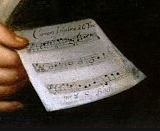Peter Medhurst explores the music of Bach (1685-1750) – arguably the high king of late Baroque music
Hausmann’s portrait of Bach
The only portrait that we have of Johann Sebastian Bach was painted by Elias Gottlob Hausmann in 1746, just four years before Bach’s death at the age of 61. Since it is the only surviving image we have of the composer, it is replicated – quite rightly – over and over again in biographies, on CDs covers, in concert programmes, and many other media where publishers would have audiences connect with the illusive man who lies behind the music.
The portrait’s pluses and minuses
The portrait – and there are several versions of it – raises, unfortunately, many pluses and many minuses. First, and on the down side, it is the work of a minor court painter whose surviving output varies considerably in style and quality. Hausmann’s impression of Bach leans towards stiffness and severity, and with its ‘old man in a wig syndrome’ may only succeed in distancing the composer from his admirers.
Bach’s pre-occupation with musical form
Second, the portrait enforces Bach’s pre-occupation with form, counterpoint and musical puzzles, since in his right hand he holds a copy of his Canon triplex a 6 voc. The canon is a musical form based on the principle of strict imitation, in which an initial melody is imitated at a specified time interval by one or more parts, either at the unison  (ie: the same pitch) or at some other pitch. The canon in the portrait is number 13 out of a sequence of 14 canons produced in Bach’s final years and which are based on the first eight fundamental notes of the aria from the Goldberg Variations. The reason that there are 14 canons in the sequence is because it represents Bach’s name in the numerical alphabet: 2 + 1 + 3 + 8 = BACH. If a listener is not interested in musical symbolism and such complexities, then immediately there is another reason to have a sense of dis-connection with the composer.
(ie: the same pitch) or at some other pitch. The canon in the portrait is number 13 out of a sequence of 14 canons produced in Bach’s final years and which are based on the first eight fundamental notes of the aria from the Goldberg Variations. The reason that there are 14 canons in the sequence is because it represents Bach’s name in the numerical alphabet: 2 + 1 + 3 + 8 = BACH. If a listener is not interested in musical symbolism and such complexities, then immediately there is another reason to have a sense of dis-connection with the composer.
So, we haven’t gone any farther than a brief viewing of Bach’s portrait before we find ourselves deep into the world of musical aesthetics. As I said, pluses and minuses.
Hausmann’s portrait might draw listeners to Bach
On the other hand, it could be argued that a detailed assessment of Hausmann’s painting might actually bring admirers to him. By the portrait’s implying that here is a composer who thinks on the highest musical level, intellectually, it is therefore worth the listener’s while to strive to understand a mind that can produce such astonishing ideas, which work not only theoretically, but succeed as music, too. Beethoven was to prove a similar point some 70, or so, years later.
Listeners need to understand how Bach thinks
There is no doubt that if listeners wish to step beyond the world of Sheep May Safely Graze, Air on a G String or the jollier moments in The Brandenburg concertos, then they are going to have to work at Bach’s music. They need to understand how Bach thinks, where his ideas come from, what his goals are aesthetically, how he challenges musical convention, what he perfects stylistically as a composer, and above all they need to see how Bach is able to rise above the mechanics of his craft in order to produce music that radiates humanity, vision, warmth and love.
This study day gets right to the heart of the greatest of late Baroque composers to see exactly what it is that gives his music its original stamp.





![The Scotish [sic] Gigg](https://petermedhurst.com/wp-content/uploads/2012/08/Peter120813untitled-shoot-2.jpg)